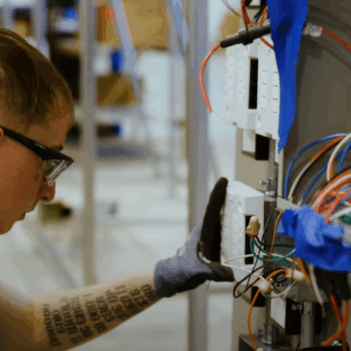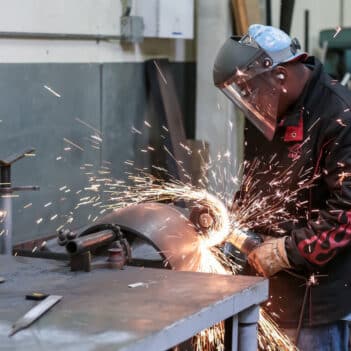News
Driving Toward a Carbon-Free Future
February 16, 2024
Out of the 15 Minnesota-based Fortune 500 companies, at least 11 have laid out formal plans to achieve net-zero emissions within varying timelines, all before 2050. Achieving these lofty goals to see significant reductions in their carbon footprint will require teams of consultants, engineers, contractors, and partners to design and execute plans that are aspirational yet practical.
MEETING THE GOALS: WHAT IT WILL TAKE
In the last decade, companies have focused hard on improving carbon reduction through transportation initiatives. While this has shown success, the next area of focus for many will be the buildings, facilities, and operations of the companies themselves.
Commercial and industrial facilities will need to take a multi-pronged approach to ensure they’re truly producing fewer carbon emissions in the future. Engineering firms have identified key areas to focus on and develop innovative solutions that eliminate carbon emissions while minimizing downtime and ensuring a smooth rollout and implementation.
1. Heating and Cooling
One of the largest areas of improvement for companies big and small is in HVAC systems. Heating and cooling buildings — especially in states with extreme weather such as Minnesota — can quickly become expensive and can increase carbon footprints. In order to effectively achieve carbon neutrality, commercial facilities will need to target their mechanical HVAC systems internally, as well as external factors that can affect their efficiency.
2. Energy Production
Commercial entities can make significant strides in emission reduction efforts by implementing renewable technology. Onsite solar and wind generation are fairly well-known sources of clean energy, and new solutions are nearing market-readiness as well. Building-integrated photovoltaic solar (BIPV) is another form of on-site solar that industrial and commercial customers can consider. Acting as both an insulated exterior as well as a solar panel, BIPV technology is making its way into the industry, allowing larger-scale opportunities to generate electricity on-site while improving the aesthetics, insulation, and efficiencies of commercial buildings.
3. Smart Buildings
Honing in on “smart buildings” is a priority for engineering and architectural firms around the country. Focusing on energy efficient LED lighting, building automation, and LEED certifications will change the way buildings are operated and companies are run. For both new builds as well as retrofit projects, engineers and contractors calculate carbon reduction through equipment replacement and overhauls, as well as integrating energy management systems. This equipment and technology enables property owners, building managers, and project leads to connect to their buildings 24/7/365, and can even qualify for various tax incentives. Engineers and contractors work together to conduct building audits to identify areas of improvement and provide recommendations to increase efficiency and reduce carbon output.
CHOOSING THE RIGHT PARTNERS
Engineers and architects are already hard at work designing custom solutions for new projects and retrofits around the state and country. Many are finding local CPA firms to partner with in order to package tax incentives and other benefits to project managers as a result of implementing carbon-reduction initiatives. The next step in the process is then to execute the plans, which requires dedicated teams of electrical and mechanical experts who understand the intricacies of installing and retrofitting such equipment.
Oftentimes, building-wide changes such as these require multiple contractors to work alongside or around each other. Selecting a single partner to complete building-wide overhauls and renovations adds conveniences and reduces bottlenecks in scheduling, as well as sharing plans and spaces.
Egan Company is uniquely positioned to become a single-source contracting partner for engineering and CPA firms seeking to deliver a single package of services to GCs, property developers, and building owners. With 12 specialty trades — including in-house MEP trades and professional services — Egan is able to plan, design, and build projects focused on decarbonization. By partnering with engineering firms who are looking for competitive packages, Egan is able to cut down on the costs of an additional contractor and keep the project tight-knit and expertly completed.
Decarbonization projects are on the rise, and both new builds and retrofits are ideal places to continue your carbon neutrality efforts. Select the right partners who have a strong position in the market to execute your plans and help achieve your goals. Egan Company continues to invest in new technology, training, and partnerships with local engineering firms who are dedicated to finding carbon-neutral solutions on a global scale.



